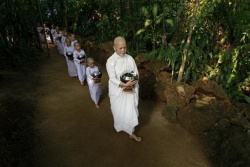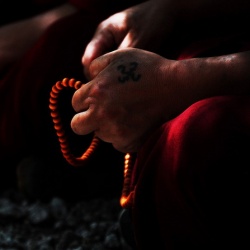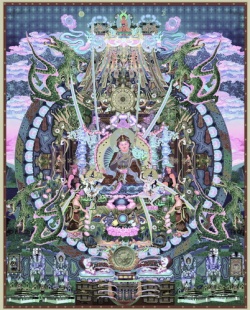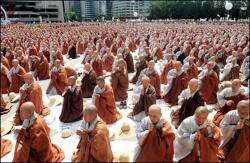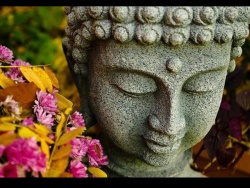Difference between revisions of "What is a rainbow body?"
m (Text replacement - "ultimate nature" to "ultimate nature") |
|||
| Line 42: | Line 42: | ||
According to [[Tibetan Buddhism]] and [[Bön]], [[Dzogchen]] is the natural, [[primordial state]] or natural [[condition]] of a [[human being]] and the practice of [[Dzogchen]] is a [[body]] of teachings and [[meditations]] aimed at [[realizing]] that [[condition]]. According to [[Dzogchen]] {{Wiki|literature}}, [[Dzogchen]] is the [[highest]] and most definitive [[path]] to [[enlightenment]]. | According to [[Tibetan Buddhism]] and [[Bön]], [[Dzogchen]] is the natural, [[primordial state]] or natural [[condition]] of a [[human being]] and the practice of [[Dzogchen]] is a [[body]] of teachings and [[meditations]] aimed at [[realizing]] that [[condition]]. According to [[Dzogchen]] {{Wiki|literature}}, [[Dzogchen]] is the [[highest]] and most definitive [[path]] to [[enlightenment]]. | ||
| − | From the {{Wiki|perspective}} of [[Dzogchen]], the | + | From the {{Wiki|perspective}} of [[Dzogchen]], the ultimate nature of all [[sentient beings]] is said to be [[pure]], all-encompassing, [[primordial]] clarity or naturally occurring timeless clarity. This intrinsic clarity has no [[form]] of its own and yet is capable of perceiving, experiencing, reflecting, or expressing all [[form]]. It does so without being affected by those [[forms]] in any [[Wikipedia:Absolute (philosophy)|ultimate]], [[permanent]] way. The analogy given by [[Dzogchen]] [[masters]] is that one's [[nature]] is like a [[mirror]] which reflects with complete [[openness]] but is not affected by the reflections, or like a {{Wiki|crystal}} ball that takes on the {{Wiki|color}} of the material on which it is placed without itself being changed. The [[knowledge]] that ensues from [[recognizing]] this mirror-like clarity (which cannot be found by searching nor identified) is what [[Dzogchenpas]] refer to as [[rigpa]]. The most direct way to [[realizing]] this state are the practices of [[Trekchö]] - an advanced practice in [[Dzogchen]]. |
[[Trekchö]] practice is a releasing or a cutting through of all one’s tensions and rigidities, all [[obscurations]] must be [[purified]]. This accomplished through mastering the [[art]] of contemplation and [[visualization]]. It is mastering [[meditation]] in the state of Union. It is a prerequisite for practicing the [[Tögal]] practice. For a [[novice]] [[understanding]] it is a practice of witnessing ones [[karma]] and forgiving and dissolving it to the point it holds no power of [[cause]]. The [[physical body]] can be [[calmed]] to a [[death]] like state of [[samadhi]]. One then is able to [[consciously]] [[contemplate]] while in a deep state of union. | [[Trekchö]] practice is a releasing or a cutting through of all one’s tensions and rigidities, all [[obscurations]] must be [[purified]]. This accomplished through mastering the [[art]] of contemplation and [[visualization]]. It is mastering [[meditation]] in the state of Union. It is a prerequisite for practicing the [[Tögal]] practice. For a [[novice]] [[understanding]] it is a practice of witnessing ones [[karma]] and forgiving and dissolving it to the point it holds no power of [[cause]]. The [[physical body]] can be [[calmed]] to a [[death]] like state of [[samadhi]]. One then is able to [[consciously]] [[contemplate]] while in a deep state of union. | ||
Latest revision as of 15:29, 31 December 2014
Tib., 'ja' lus; Rainbow body
Skt., indracapa; Bow of Indra
Based on the Tibetan terms lus (that which is left behind, ordinary body) and 'ja' (rainbow, rainbow hue), the Rainbow Body or Vajra Rainbow Body ('ja' lus rdo rje'i sku) is not so much a "body" but rather a vortex of energy into which certain adepts can apparently transform themselves on dying.
Rather than leaving a corpse behind that needs to be cremated or chopped to pieces, highly accomplished men and women rather pass away in a mass of rainbow light. To use a Tibetan phrase, they "dissolve into space like a rainbow" (nam mkha' la 'ja' yal ba ltar); a process which - curiously enough - is reported as leaving the practitioners hair and nails behind as physical remnants.
The Tibetan concept of the rainbow is different from the Western (five instead of seven colors). Each of the five colors corresponds to one of the five gross elements that form the material, physical body. Based on this, one finds expressions such as the sphere of five-colored rainbow light ('ja' tshon 'od lnga'i klong) and the light body of the five essences (lnga ldan snying po 'od kyi lus), both of which are poetic synonyms for 'ja' lus, the rainbow body.
Those who will attain the body of rainbow light ('ja' lus bsgrub pa), who - in other words - undergo the great transformation of the rainbow body ('ja' lus 'pho ba chen po), must have learned to cease all grasping and to have exhausted all fixations. This inner cleansing of all attachments, so difficult to realize for human beings, is at the core of the practice known as Thogal or Tögal (Thod-rGal), the "All-Surpassing Realisation" that is part of the Concealed Instructions Series of Dzogchen teachings.
As the above used term great transformation of the rainbow body ('ja' lus 'pho ba chen po) clearly shows by its use of 'pho ba, we're also dealing here with the technique known as Phowa or Powa; the so-called "Transformation Yoga" (Skt., samkranti; Tib., pho-ba) that aims at the conscious ejection or transference of consciousness (to a higher realm) at the moment of death. It is one of the six yogas or doctrines taught by Naropa and Niguma in their respective cycles of teachings; the Naro Chosdrug and Nigu Chosdrug. In order to attain the rainbow body one must complete the four visions ( nangwa zhi) of Togal. This is why Therevada and Zen masters dont manifest the rainbow body.
The rainbow body is standard in Buddhist Dzogchen and someone that have a rainbow body is not a sentient being anymore. Eternity and time and pure or non-pure is not a subject for them. Nor do they dwell anywhere in particular. They are fully enlightened Buddhas. One can be liberated from samsara without attaining the rainbow body. The rainbow body is just one way in which the potentiality of buddhahood is actualized and it is only done through the higher trainings of Buddhist Dzogchen. There is no contradiction, the dzogchen teachings recognize the different methods of practice and liberation of the other 8 yanas. According to Tibetan Buddhism an Arhat is liberated from samsara but this is not the full liberation of Buddhahood. Their defilements are eliminated but they still have some obscurations regarding wisdom.
When an Arhat dies, they are reborn in a formless realm where they are in constant meditation. After a long, long time (cosmic time here) they are roused from their samadhi by a Buddha and are reborn as high Bodhisattvas (6-8th bhumi).
A fully enlightened person (a jivan mukti) who also liberates the body into light.
Now there are 3 levels of the Rainbow body:
A) Rainbow body
B) Rainbow body of light
C) Rainbow body of great transference
A) The most common level is the normal Rainbow body that occurs only after body death. Every 10 years or so a Buddhist from Tibet enters into this state. There are no physical signs indicating the start of the process before death and once physical death occurs it takes on average 7 days for the body to shrink and dissolve into light and most of the time a small child size body remains behind and in more advanced yogi's only hair and nail
Chokgyur Lingpa rainbow body (Only a small body of around 5 cm remained)
B) The more advanced level is also called the Rainbow body, but for due purposes lets call it the Rainbow body of light as in this level all the signs are showing up while the yogi is still alive. The process of dissolving into light might go really fast but in most cases it takes month to years to complete, all while remaining fully functional. It is also possible that the yogi who is in the middle of this process slows it down or is unable to continue the process and dies before the completion of the Rainbow body. This has been the case with most of the famous siddhars. If the process is continued the body will start to shrink and shine real light over time until it reaches the size of a baby and then as a flash of bright rainbow light will disappear into emptiness forever.
C) The most advanced and extremely rare level is the attainment of the Rainbow body of great transference. In this level the yogi not only dissolves the body completely into light but remains functional and visible as light. For clarification, these 3 states have nothing to do with Spontaneous Human Combustion SHC and some have made the mistake of believing some saints to have attained the Rainbow body state while in fact it was a SHC case, such as Sambandar, Appar and Sundarar.
So lets go a little deeper into the history and background of the phenomena called the Rainbow body.
The ultimate Great accomplishment in meditation is the attainment of the Rainbow body. This is widely recognized as a sign of extreme sanctity in Tibetan Buddhism and among the Bönpo. Reports of this level of transmutation are rare, but still they occur and have been chronicled far into antiquity. The rainbow body however is not limited to Buddhism only as you will see in the pictures below but to understand the process we will turn to the well documented and delineated practice of Dzogchen in Tibet and reflect this practice to the stories of Vallalar from south India who went through the same process.
In the Himalayan regions, the early indigenous religion was that of the Bön. Bön pre-existed the creation of both the sovereign territories, later to become the country of Tibet as well as of Buddhism. When the great Indian tantric sage Padmasambhava (look at drawing above) brought Buddhism from India to Tibet in the 8th Century AD he found the richly tilled ground of the Bönpo. This land and its peoples took easily to the Buddha’s teachings and the Buddhist beliefs melded well with the rituals of the Bön.
When Padmasambhava left at the end of his time in physical form he dissolved his body completely back to their natural elements leaving nothing behind. At that moment a new lineage of Buddhist teachings was created. This was the start of what has become the Nyingma tradition and is the foundation of Tibetan Buddhism as we have come to know it. At the heart of the Nyingma tradition is the practice of Dzogchen otherwise called Ati Yoga or the Great Perfection.
According to Tibetan Buddhism and Bön, Dzogchen is the natural, primordial state or natural condition of a human being and the practice of Dzogchen is a body of teachings and meditations aimed at realizing that condition. According to Dzogchen literature, Dzogchen is the highest and most definitive path to enlightenment.
From the perspective of Dzogchen, the ultimate nature of all sentient beings is said to be pure, all-encompassing, primordial clarity or naturally occurring timeless clarity. This intrinsic clarity has no form of its own and yet is capable of perceiving, experiencing, reflecting, or expressing all form. It does so without being affected by those forms in any ultimate, permanent way. The analogy given by Dzogchen masters is that one's nature is like a mirror which reflects with complete openness but is not affected by the reflections, or like a crystal ball that takes on the color of the material on which it is placed without itself being changed. The knowledge that ensues from recognizing this mirror-like clarity (which cannot be found by searching nor identified) is what Dzogchenpas refer to as rigpa. The most direct way to realizing this state are the practices of Trekchö - an advanced practice in Dzogchen.
Trekchö practice is a releasing or a cutting through of all one’s tensions and rigidities, all obscurations must be purified. This accomplished through mastering the art of contemplation and visualization. It is mastering meditation in the state of Union. It is a prerequisite for practicing the Tögal practice. For a novice understanding it is a practice of witnessing ones karma and forgiving and dissolving it to the point it holds no power of cause. The physical body can be calmed to a death like state of samadhi. One then is able to consciously contemplate while in a deep state of union.
As Drubwang Tsoknyi Rinpoche once explained:
"Trekchö is the thorough cut of cutting through, cutting the obscurations completely to pieces, like slashing through them with a knife. So the past thought has ceased, the future thought hasn't yet arisen, and the knife is cutting through this stream of present thought. But one doesn't keep hold of this knife either; one lets the knife go, so there is a gap. When you cut through again and again in this way, the string of thought falls to pieces. If you cut a rosary in a few places, at some point it doesn't work any longer."
When the state of full Self-realization has been accomplished, the yogi or yogini is ready for the next and last Dzogchen practice, the practice of Tögal. This final practice enables the master yogi or yogini to dissolve his or her physical body into the essence of the elements at the time of death. The master disappears into a body of light becoming the wisdom body, the term is called ‘Ja’-lus or Rainbow body in Tibetan. This level of attainment is also the central aim of Indian Buddhist tantricism known as Vajrayana that the Taoists call the golden body. Another term frequently used is Soruba Samadhi or Gnana Deham as Vallalar used to called it. It is a golden body, a state of God-realization in which Divinity descends and transforms the spiritual, intellectual, mental, vital and physical bodies. It is considered physical immortality or the highest perfection.
The practice Tögal occurs in a deep state of contemplation union and is a practice of becoming the essence of all that is. In essence this practice shifts identity to the Cosmic-Awareness. In duality there is always an observer versus the rest. Even in deep meditation there always seems to be an observer left who can realize or recognise things. However if the Trekchö practice has done its job in cleaning and clearing all the blockages, karma and thoughts, the meditation might enter into a state called nirvikalpa samadhi - but in that state all is emptiness and the body is non functional. In Tögal there is a way around this by going into the non-breathing state but remaining fully functional and by doing this you automatically dive into the source of the observer and root it out completely. What remains is the essence of all that is without an observer. Vallalar called this practice Gathi and that was the starting point of the formation of the Rainbow body.
Often masters that attain the Rainbow body will return one last time out of compassion for their beloved disciples and give what are known as posthumous teachings, delivered in the form of a last testament. Often the master is in the transfigured state on occasion suspended in the sky
B) Rainbow body of light
(otherwise referred to as Soruba samadhi or in more detail Pranava Deham, Suddha Deham and finally Gnana Deham)
According to the description done by Vallalar, in those who have reached the state of Pranava and Suddha Deham, the beginning stages of the rainbow body while still alive, body changes start occurring starting off with a the inner and outer skin becoming extraordinarily smooth; nerves and muscles relax gradually; bones, membranes and cartilages become automatically flexible; blood and semen changes from a liquid to a thickened state; the brain and all its parts became spongy expanded like a flower; through the entire body leaks the Amrit - "Nectar of the Goddess" - the drink flowing from the crown chakra down into the body and tastes sweet like burned sugar when it passes through the throat chakra and grants immortality when it flows nonstop. The face become brilliant, delicate and harmonious, making evident the internal state of supreme happiness.
When this state deepens the senses can perceive all without being limited by any barrier or obstacle; the eyes can have a view of whole Universe, by that reason they aren't interested in observing the things of the world; they are able to see the content of all the worlds and beings (as much external as internally), without this vision may be hindered by dense barriers like walls or high like mountains; their tongue taste all the flavours, their skin experiences all tactile sensations, their nose sniffs all the smells, their ears are filled of melodies being able to listen any sound produced in any place. With their arms and hands they can take one thing independently of the distance, or give it to other there where he may be; they can reach any destiny without need that their legs do some physical movement, moving without step the ground; with their voice can communicate with anybody in any place of the universe and still beyond. They will be free from the need to consume food, from satisfy the sexual impulse and from feel fear; the body exempt from defects and impurities is refreshed, does not excrete, does not perspire and does not project shadow on the ground; their external appearance corresponds approximately to twelve years old; their hair doesn't become grey, their skin doesn't become wrinkle, they do not age and do not be under the control of death. Their breast and heart swell up palpitating of Love; the four aspects of the mind are illuminated and in total harmony; all the visible parts of the body radiate ecstacy; the ego has disappeared. God, in the form of Supreme Love, fills those Pure bodies with Divine Life.
Not being subjected to any limitation, those who have achieved the Pranava and Suddha Deham states are able to create and destroy according to their own will, to resurrect a dead person and return an elder to the youth. Their knowledge is God's Knowledge, their action is God's Action, their experiences come from God himself, being manifested the Divine Grace through them. Even the most insignificant inanimate thing will be called to enter into a conscious life only by the Grace of their Look and by their mere Presence; the Greatness and the Glory of their Divine State necessarily will cover what is said by the six traditional spiritual disciplines (Vedanta, Siddhanta, Kalanta, Bodhanta, Nadanta -Tantra- and Yoganta), but will transcend and surpass all of them, being this Divine State what will carry them to achieve the Total and Perfect Bliss.
In one of his poems Vallalar assures having experienced Pranava Deham transformation and evolved even more. By doing it, the Supreme Grace was manifested as total Bliss. Ramalinga explains how he realized the experience of the highest and ultimate transformation: the transmutation in the Divinity, which he described as the fusion with the Supreme God's Body. This Body of Bliss, or Gnana Deham, is omnipresent but imperceptible for the senses.
C) Rainbow body of great transference / ja lü phowa chenpo:
This state is similar to the rainbow body of light state, however the process of shrinking goes much faster and in most cases almost instantaneous and the light body remains visible for those who are in need for their help. Now keep in mind that the light body that remains is not a person or individual as we know it. It is divine itself in the form of light. It has no will nor desire and only remains for those who are attuned to it.
